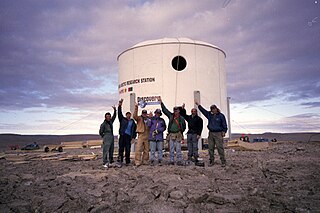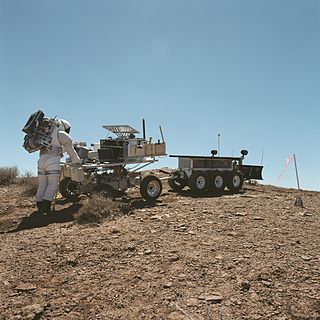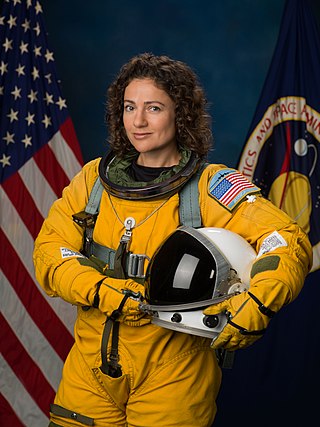The Mars Society is a nonprofit organization that advocates for human Mars exploration and colonization. It was founded by Robert Zubrin in 1998 and based on Zubrin's Mars Direct philosophy, which aims to make human mission to Mars as lightweight and feasible as possible. The Mars Society aims to generate interest in the Mars program by garnering support from the public and lobbying. Many Mars Society members and former members are influential in the wider spaceflight community, such as Buzz Aldrin and Elon Musk.

Ilan Ramon was an Israeli fighter pilot and later the first Israeli astronaut. He served as a Space Shuttle payload specialist on STS-107, the fatal mission of Columbia, in which he and the six other crew members were killed when the spacecraft disintegrated during re-entry. At 48, Ramon was the oldest member of the crew. He is the only foreign recipient of the United States Congressional Space Medal of Honor, which was awarded posthumously.

The Mars Desert Research Station (MDRS) is the largest and longest-running Mars surface research facility and is one of two simulated Mars analog habitats owned and operated by the Mars Society.

Colonization or settlement of Mars is the theoretical human migration and long-term human establishment of Mars. The prospect has garnered interest from public space agencies and private corporations and has been extensively explored in science fiction writing, film, and art.

The Flashline Mars Arctic Research Station (FMARS) is the first of two simulated Mars habitats located on Devon Island, Nunavut, Canada, which is owned and operated by the Mars Society. The station is a member of the European Union-INTERACT circumarctic network of currently 89 terrestrial field bases located in northern Europe, Russia, US, Canada, Greenland, Iceland, the Faroe Islands, and Scotland as well as stations in northern alpine areas.

NASA's Desert Research and Technology Studies is a group of teams which perform an annual series of field trials seeking to demonstrate and test candidate technologies and systems for human exploration of the surface of the Moon, Mars, or other rocky bodies.

The Lab-on-a-Chip Applications Development (LOCAD) element is a set of related lab-on-a-chip projects at NASA. The projects develop integrated lab-on-a-chip products in three areas related to space exploration: Environmental Control and Life Systems Support (ECLSS), Medical Systems, and Remote Exploration. NASA conducts activities related to these projects both at NASA Marshall Space Flight Center and aboard the International Space Station (ISS).

The idea of sending humans to Mars has been the subject of aerospace engineering and scientific studies since the late 1940s as part of the broader exploration of Mars. Some have also considered exploring the Martian moons of Phobos and Deimos. Long-term proposals have included sending settlers and terraforming the planet. Proposals for human missions to Mars have come from e.g. NASA, CNSA, European Space Agency, Boeing, and SpaceX. As of 2023, only robotic landers and rovers have been on Mars. The farthest humans have been beyond Earth is the Moon, under the Apollo program.

Astronauts and cosmonauts, and spaceflight participants have observed their religions while in space; sometimes publicly, sometimes privately. Religious adherence in outer space poses unique challenges and opportunities for practitioners. Space travelers have reported profound changes in the way they view their faith related to the overview effect, while some secular groups have criticized the use of government spacecraft for religious activities by astronauts.

Mars to Stay missions propose astronauts sent to Mars for the first time should intend to stay. Unused emergency return vehicles would be recycled into settlement construction as soon as the habitability of Mars becomes evident to the initial pioneers. Mars to Stay missions are advocated both to reduce cost and to ensure permanent settlement of Mars. Among many notable Mars to Stay advocates, former Apollo astronaut Buzz Aldrin has been particularly outspoken, suggesting in numerous forums "Forget the Moon, Let’s Head to Mars!" and, in June 2013, Aldrin promoted a crewed mission "to homestead Mars and become a two-planet species". In August 2015, Aldrin, in association with the Florida Institute of Technology, presented a "master plan", for NASA consideration, for astronauts, with a "tour of duty of ten years", to colonize Mars before the year 2040. The Mars Underground, Mars Homestead Project / Mars Foundation, Mars One, and Mars Artists Community advocacy groups and business organizations have also adopted Mars to Stay policy initiatives.
Human analog missions are activities undertaken on Earth in various environments to simulate aspects of human missions to other worlds, including the Moon, asteroids, and Mars. These remote field tests are performed in locations that are identified based on their physical similarities to the extreme space environments of a target mission. Such activities are undertaken to test hardware and operational concepts in relevant environments.

Jessica Ulrika Meir is an American NASA astronaut, marine biologist, and physiologist. She was previously an assistant professor of anesthesia at Harvard Medical School, Massachusetts General Hospital, Boston, following postdoctoral research in comparative physiology at the University of British Columbia. She has studied the diving physiology and behavior of emperor penguins in Antarctica, and the physiology of bar-headed geese, which are able to migrate over the Himalayas. In September 2002, Meir served as an aquanaut on the NASA Extreme Environment Mission Operations 4 crew. In 2013, she was selected by NASA to Astronaut Group 21. In 2016, Meir participated in ESA CAVES, a training course in which international astronauts train in a space-analogue cave environment. Meir launched on September 25, 2019, to the ISS onboard Soyuz MS-15, where she served as a flight Engineer during Expedition 61 and 62. On October 18, 2019, Meir and Christina Koch were the first women to participate in an all-female spacewalk.
The Austrian Space Forum (OeWF) is an expert organization in the field of analogue research, which researches how humans can prepare on Earth for astronautical exploration of other planets. Since the AustroMars mission in 2006, OeWF has been involved in analog research, developing space suit simulators and also conducting astronautical simulations on Earth. The resulting data is available to researchers from a wide range of disciplines in the Multi-Mission Science Data Archive

Psychological and sociological effects of space flight are important to understanding how to successfully achieve the goals of long-duration expeditionary missions. Although robotic spacecraft have landed on Mars, plans have also been discussed for a human expedition, perhaps in the 2030s, or as early as 2024 for a return mission.
A Mars analog habitat is one of several historical, existing or proposed research stations designed to simulate the physical and psychological environment of a Martian exploration mission. These habitats are used to study the equipment and techniques that will be used to analyze the surface of Mars during a future crewed mission, and the simulated isolation of the volunteer inhabitants allows scientists to study the medical and psychosocial effects of long-term space missions. They are often constructed in support of extensive Mars analogs. However, sometimes existing natural places are also valued as Mars analogs. Crewed Mars habitats are featured in most human Mars missions; an alternative may be terraforming or telepresence.

A Mars habitat is a hypothetical place where humans could live on Mars. Mars habitats would have to contend with surface conditions that include almost no oxygen in the air, extreme cold, low pressure, and high radiation. Alternatively, the habitat might be placed underground, which helps solve some problems but creates new difficulties.

Jessica Andrea Watkins is an American NASA astronaut, geologist, aquanaut and former international rugby player. Watkins was announced as the first Black woman who completed an International Space Station long-term mission in April 2022. On June 9, 2022, at 7:38 UTC, she became the African American woman with the most time in space, surpassing Stephanie Wilson's 42 day, 23 hour and 46 minute record.

Niamh Shaw is an Irish scientist, engineer, STEM communicator, writer, and performer.















